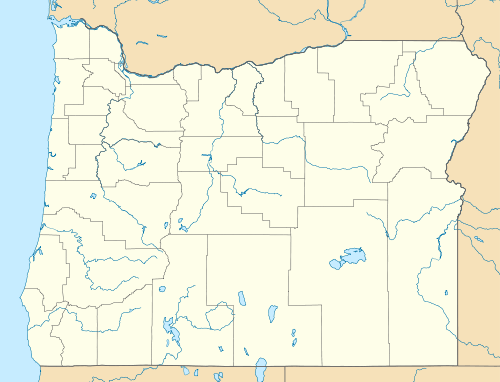Whitney, Oregon
| Whitney, Oregon | |
|---|---|
| Unincorporated community | |
|
Post office in Whitney, about 1900–1910 | |
 Whitney, Oregon  Whitney, Oregon | |
| Coordinates: 44°39′34″N 118°17′27″W / 44.65944°N 118.29083°WCoordinates: 44°39′34″N 118°17′27″W / 44.65944°N 118.29083°W | |
| Country | United States |
| State | Oregon |
| County | Baker |
| Elevation | 4,160 ft (1,270 m) |
| Time zone | Pacific (PST) (UTC-8) |
| • Summer (DST) | PDT (UTC-7) |
| Area code(s) | 458 and 541 |
| GNIS feature ID | 1152282[1] |
Whitney is an unincorporated community, also considered a ghost town, in Baker County, Oregon, United States, on Oregon Route 7 southwest of Sumpter. It is on the North Fork Burnt River, near the Blue Mountains and Wallowa-Whitman National Forest.
Whitney was named for a pioneer in the county, C.H. Whitney. The community of Whitney had a post office from 1901 to 1943.[2]
Founded as a logging town and platted in 1900,[3] Whitney was the primary station on the narrow gauge Sumpter Valley Railway.[3][4] The Oregon Lumber Company built the first sawmill. It burned down in 1918, causing the town to severely decline. It was rebuilt in 1939 by the Oregon Lumber Company to harvest some nearby newly purchased timber stands.[5] The Nibley Lumber Company built a second sawmill in 1910–11 on the south side of town.[6] It was a picturesque ruin well into the 21st century, but as of 2008 was completely gone. Logging declined in the area in the 1940s, which caused the town and the railroad to fade.[3]
According to a United States Forest Service sign on the road:
- A Town Named Whitney ~ Rails of the Sumpter Valley R. R. reached Whitney Valley June 1, 1901. Originally a timber company town, Whitney grew to become the main head of the Stage Lines to mining and cattle towns such as Unity, Bridgeport and Malheur City.
- Logging railroads were built in all directions out of Whitney during the next 20 years. Nibley Lumber Company set up a large sawmill south of town in 1911 as loggers "Daylighted" the large stands of pine nearby. At one time over 150 people called Whitney their home. When the railway was abandoned in 1947, the town closed its doors.
The Antlers Guard Station, which is on the National Register of Historic Places, is in the Whitney area.[7][8]
See also
References
- ↑ "Whitney (historical)". Geographic Names Information System. United States Geological Survey. November 28, 1980. Retrieved November 10, 2016.
- ↑ McArthur, Lewis A.; Lewis L. McArthur (2003) [1928]. Oregon Geographic Names (Seventh ed.). Portland, Oregon: Oregon Historical Society Press. p. 1034. ISBN 0-87595-277-1.
- 1 2 3 Bailey, Barbara Ruth (1982). Main Street: Northeastern Oregon. Oregon Historical Society. pp. 22, 51. ISBN 0-87595-073-6.
- ↑ "Whitney". ghosttowns.com. Retrieved October 19, 2006.
- ↑ Weis, Norman D. (January 8, 1993). Ghost Towns of the Northwest. Caxton Press. ISBN 9780870043581.
- ↑ Hilton, George Woodman (January 1, 1990). American Narrow Gauge Railroads. Stanford University Press. ISBN 9780804717311.
- ↑ "Antlers Guard Station" (PDF). USDA Forest Service. Retrieved October 19, 2006.
- ↑ "Oregon—Baker County". National Register of Historic Places. Retrieved October 19, 2006.

